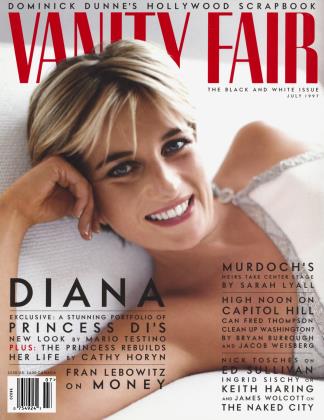Sign In to Your Account
Subscribers have complete access to the archive.
Sign In Not a Subscriber?Join NowContributors
At age 10, Max Vadukul discovered the work of William Heath Robinson when he saw a schoolmate laughing hysterically at something in a book. "I leaned over to see what was so funny and saw these incredible inventions," recalls Vadukul, who had just moved from Africa to London and spoke no English. "I had lived in Peter Beard land—with lions and giraffes—and knew nothing of machinery. That was really my introduction to modernity-through-humor." Vadukul has dreamed for a decade of shooting the portfolio (top inset, with actor Mike Myers; bottom, some props) that begins on page 86.
By the time he teamed up with Jacob Weisberg for their story on actorturned-senator Fred Thompson, special correspondent Bryan Burrough had seen almost all of Thompson's 24 movies, including the HBO adaptation of Burrough's best-seller, Barbarians at the Gate. At the premiere of that film, in which Thompson played American Express chairman Jim Robinson, Burrough managed to meet most of the stars— except the one who is now heading the Senate campaign-finance investigation.
He is only 32, but Chicago native Jacob Weisberg, who joined forces with Bryan Burrough to report on the travails of Senator Fred Thompson, is already a veteran journalist. The Slate columnist wrote his first national magazine article at age 17, for The Washington Monthly, on the subject of potholes, before going on to cover politics for The New Republic, Newsweek, and New York magazine, and to write In Defense of Government, Interview editor and V.F. contributing editor Ingrid Sischy, who chronicles the brief life of modern-art star Keith Haring on page 106, believes that "the hardest thing about art is to not rely on the old stuff. This is one of the reasons I'm a non-nostalgic person. I'm attached to living things: people, ideas ... I could pick up and go in about eight minutes— I'm not into possessions." In fact, on a recent trip to Chicago, Sischy reports, "they almost wouldn't let me on the plane, because I don't own a picture ID."
CONTINUED ON PAGE 28
CONTINUED FROM PAGE 26
"She has an allure no one can put a finger on," says contributing editor Cathy Horyn of Princess Diana. "It's a combination of rank and beauty—and perhaps that she's always the tallest person in the room." In this issue, Horyn takes inventory of the 79 dresses that Diana is sending to auction at Christie's this month, and of the life that went with them. "My favorite is one that isn't there," she says, "a strapless gown Diana wore to a charity gala prior to her marriage. London was buzzing over its deep decolletage."
Like artist William Heath Robinson, his subject this month, Christopher Hitchens is, and always has been, utterly bewildered by machines of any kind. As a boy, he had absolutely no clue how to build a model airplane; as a grown man, the V.F. contributing editor cannot fix a fuse, cannot change a lightbulb, cannot drive a car, and cannot operate a word processor.
"I probably should have finished college before I moved to New York," contributing editor James Wolcott admits, "but I had a job recommendation for The Village Voice, and I was afraid that if I waited until graduation it would be old and yellowy and I might lose my nerve."
In his column this month, Wolcott tours New York noir and ends up in his original neighborhood:
"I lived in a run-down hotel near the old Belmore Cafeteria, where all the cabbies would hang out."
Being pregnant presented obvious burdens for Sarah Lyall as she tracked down three of Rupert Murdoch's children for her story on page 44, but it also gave her some welcome breaks: her condition inspired sympathy—and a little extra candor—from those she interviewed, and she received some great pregnancy tips from Murdoch's daughter Elisabeth, who was also "with child" at the time. Lyall writes from London for The New York Times.
 View Full Issue
View Full Issue
Subscribers have complete access to the archive.
Sign In Not a Subscriber?Join Now